
So today will mark the opening of the Olympic Games. Some will cheer for their states; some will cheer for their heroes; some won’t care.
Well, here are FOURTEEN reasons to care: reasons that transcends national barriers and in many ways is more reflective of our Sikh-centered, globalized outlook. It is related to the fact that Sikhs from throughout the world congregate here at The Langar Hall and that issues ranging from Kenya, New Zealand, Canada, Panjab, England etc. all interest us
So in this spirit of continuing to foster a globalized Sikh diasporic community, I present to you the untold story of Punjabi Sikhs in the Olympics. The reason I am using the term ‘Punjabi Sikh’ is because I don’t really know how they identify themselves, but their names indicate that they come from a common ethnic stock – a Punjabi Sikh background.
I am trying to make this list comprehensive, so if I left anyone out, please feel free to post a comment and I will go back to add them. Let’s make this a project we do together, by posting their finishings and results. [also thank you to Mandeep Singh for correcting some of my mistakes]
Sikhs in the Olympics:
Sikhs are one of those great unknown Olympic stories. It is a diasporic story where Sikhs have representeed many countries and many continents. In the Beijing Olympics, there will be Sikhs (on as far as I could figure out using the wikipedia lists) coming from India and Canada. In years past, Sikhs have been included on teams from Kenya, Great Britain, and even Malaysia. From the regions of the five Olympic Rings (Blue – Europe, Yellow – Asia, Black – Africa, Green – Oceania, Red – Americas), Sikhs, including those in the diaspora have been at the center of many Gold medal winning teams – especially in field hockey. As far as individual glory, Milkha Singh “the Flying Sikh” disappointing fourth place finish in the Men’s 400M in the 1960 Rome Olympics.
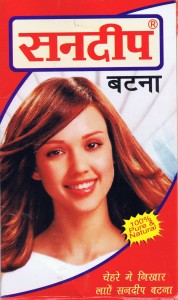 So it’s wedding season for many Panjabis in the Diaspora and one key product commonly used across South Asian groups is batnaa (the yellow mixture used on a groom/bride a day before the wedding to clear up the complexion). Guess what? Jessica Alba is now on boxes of Batnaa! When I saw this I laughed and got confused … what is going on here? I find it interesting that Alba is on the box … maybe it’s because she “looks” more South Asian than say Hillary Duff? Any other ideas?
So it’s wedding season for many Panjabis in the Diaspora and one key product commonly used across South Asian groups is batnaa (the yellow mixture used on a groom/bride a day before the wedding to clear up the complexion). Guess what? Jessica Alba is now on boxes of Batnaa! When I saw this I laughed and got confused … what is going on here? I find it interesting that Alba is on the box … maybe it’s because she “looks” more South Asian than say Hillary Duff? Any other ideas?


Also, American stars are being used to market traditional South Asian products rather than relying on Bollywood stars. Anyone else out there seen something similar in marketing other traditional South Asian products?
Earlier in the month, an East Panjabi newspaper editor, Baljit Brar, posed the possibility that Pakistan stood to earn up to $500 million per year by promoting Sikh tourism.
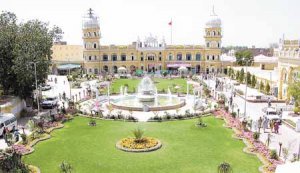 Brar suggests that since the airport in Lahore is more convenient and is better maintained than that in Amritsar, with better border mobility the Lahore airport could be the airport of choice for diasporic Sikhs. Many Sikhs have bought into the ‘Romance that is Panjabiyat,’ including at-times the present langa(w)r-iter. While Brar’s numbers may be grossly optimistic, I do believe that many Sikhs would love to take advantage of new tourism and travel opportunities.
Brar suggests that since the airport in Lahore is more convenient and is better maintained than that in Amritsar, with better border mobility the Lahore airport could be the airport of choice for diasporic Sikhs. Many Sikhs have bought into the ‘Romance that is Panjabiyat,’ including at-times the present langa(w)r-iter. While Brar’s numbers may be grossly optimistic, I do believe that many Sikhs would love to take advantage of new tourism and travel opportunities.
Many Sikhs left West Panjabi villages and cities in their stead in 1947. Another langa(w)r-iter had commented on the traumas of Partition. The opportunity to revisit one ancestral home may be part of the process in healing old wounds.
Brar makes a number of suggestions. In a world where economics flows across borders, new opportunities may avail themselves to the Sikhs to increase the prosperity of Panjab. One hopes governments can help create an environment where greater flows are possible. I definitely have longed to visit West Panjab. What about you? Is something like this feasible?
While Sikhs have lived in the U.S. for over 100 years, our numbers have grown tremendously after 1960s immigration reform. With this increase in numbers, we’re beginning to see the first long-term interactions between waves of immigrants and within generations of immigrants. These shifts in demographics, in concert with growth in the population of U.S.-born Sikhs, have created a space in which we are re-visioning and exploring advocacy and expression on behalf of the Sikh community.
Among many U.S.-born and 1.5-generation Sikhs, this advocacy and participation has happened through the creation of new institutions. Sidestepping the process of sangat-based decision-making, a slew of new “community-focused” advocacy organizations have popped up. Many of the organizations we now think of as household names (SALDEF – formerly SMART, Sikh Coalition, United Sikhs, Ensaaf) were founded in the last 15 years. While these same organizations provide important legal advocacy tools, a lack of coordination between organizations, paired with a hesitancy to engage Sikh spiritual organizations, at best leads to confusion around a cohesive, unified Sikh voice/message. At its worst, this failure to work together leads to the creation of campaigns that often either duplicate efforts or undermine each others’ work.
When an author chooses to write a memoir, they take the risk of unveiling a plethora of secrets that otherwise (and perhaps preferably) would remain buried. And when that author is Punjabi Sikh, it is almost guaranteed that issues will be brought up that make people uncomfortable. 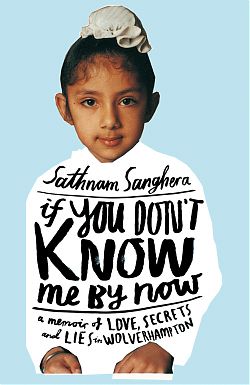 For our parents’ generation, secrets remain in the family and they are never discussed in public – we are raised to uphold the family izzat (honor). But at what cost do we remain quiet? A new memoir by Sathnam Sanghera, If You Don’t Know Me By Now: A Memoir of Love, Secrets and Lies in Wolverhamptom, opens up the dialogue around being raised in a working-class Punjabi immigrant family and being a child living in a family paralyzed by schizophrenia. Some of these experiences can be felt universally throughout the Panjabi community and others are more personal, but what is clear is that there is a great need in our community to dialogue about these issues.
For our parents’ generation, secrets remain in the family and they are never discussed in public – we are raised to uphold the family izzat (honor). But at what cost do we remain quiet? A new memoir by Sathnam Sanghera, If You Don’t Know Me By Now: A Memoir of Love, Secrets and Lies in Wolverhamptom, opens up the dialogue around being raised in a working-class Punjabi immigrant family and being a child living in a family paralyzed by schizophrenia. Some of these experiences can be felt universally throughout the Panjabi community and others are more personal, but what is clear is that there is a great need in our community to dialogue about these issues.
I clutched my schoolbag tightly as I walked along with Dad, as if my life and dignity depended on its contents (which, in a way, they did), mumbled the Japji Sahib, the beginning of the Guru Granth Sahib Mum had taught me, and watched Dad hum to himself – Hindi songs I didn’t recognise from Bollywood films I’d never seen – click his fingers to some beat I couldn’t hear, and smile, at people going past, at nothing in particular. [Link]
While I haven’t yet read the memoir (it is being released in March), several articles discuss his story at length. It wasn’t until he was in his twenties that Sanghera realized his father was a paranoid schizophrenic and his older sister also shared the condition. Intermingled within that tale is Sanghera’s own story of being a young Sikh boy growing up in Wolverhampton (one of the most densely populated Sikh communities in the UK).
The pundits (is that really an appropriate word here?) were right, the Musharraf coalition suffered a crushing defeat. The party of the slain Benazir Bhutto, the PPP, gathered 31%of the national assembly seats(83/272), Nawaz Sharif’s PML-N gained 25% (69/272), and the Musharraf-backed PML-Q collected 16% (43/272).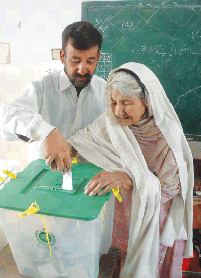
What we know from the votes?
- The PPP, although the largest party at the center, will need a coalition partner. Whether it goes with the pro-Musharraf PML-Q or anti-Musharraf PML-N will have huge ramifications on the immediate future of the country. The PML-N has vowed to work towards Musharraf’s impeachment. The PPP has made no such indication at present. However, even if the two rivals – the PPP and PML-N – form a coalition, they will not have enough votes to impeach Musharraf.
- At the state-level, the election shows the divided Pakistani populace. The PPP won a majority in the Sindh Assembly. Sindh has traditionally been the PPP’s base region. In the most populous state, Punjab, Nawaz Sharif’s PML-N is the largest party with more than 1/3 of the total assembly seats (101/297). Nawaz Sharif comes from a huge steel magnate family based out of Lahore.
- The PPP is the only national party in Pakistan.
- Musharraf is the biggest loser of the election in that his popularity was largely eroded due to his dealings with the Chief Justice and the lawyer protests, his invasion of the Lal Masjid, and his widely being blamed for the assassination of Benazir Bhutto.
- The religious coalition in the important NWFP, the MMA, unraveled and led to a victory by the ANP, a secular Pashtun nationalist party. It seems the attempt to impose harsh interpretations of shariat law led to the defeat of the incumbent MMA.
Dedicated to “The man on the bridge in Modinagar and the victims of Air India Flight 182,” Can You Hear the Nightbird Call?, is said to be one of the recommended reads for Sikhs everywhere. While there are numerous historical accounts of the Partition, Operation Bluestar, and the Delhi riots – this is one of the few fictional accounts I have come across where the same feeling and emotions rise to the surface as they do when we think back to those events.
The author, Anita Rau Badami recalls,
[It was] just after Indira Gandhi was assassinated by two of her Sikh bodyguards. I’d been married two weeks. My husband and I were traveling back to Delhi after our honeymoon. In Modingar, a town close to Delhi, we saw a Sikh man standing on a bridge… his turban removed, his long hair unbound, his arms pinned to his sides by a car tire, surrounded by a group of hoodlums. Somebody tossed something at him and the next moment the man was on fire. [Link]
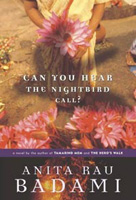 This event is the seed for the novel. The story spans over half a century, from the Partition in 1947 to the Delhi riots following the events of 1984 and finally to the explosion of the Air India flight in 1985. It’s the story of the intersection between personal concerns and larger ethical and political ones. Bibiji, Nimmo, and Leela are the three main characters of the novel – three women whose lives merge and diverge by chance yet are linked through the political turmoil and destruction in Panjab, first during the 1947 partition and then again during the events of 1984. Bibiji grows up in Panjab and as a teenager manages to steal her sister’s husband-to-be and moves with him to Vancouver. Leela, a half-German woman from Banglore, also follows her husband to Vancouver and befriends Bibiji. Nimmo, my favorite character, remains in Delhi and is a direct witness to the partition. She is also Bibiji’s niece and in a twist of fate, she reluctantly agrees to send her oldest son, Jasbeer, to live with Bibiji in Canada. It’s a heartbreaking decision that Nimmo will come to regret. Interestingly, Badami’s three heroines were partly inspired by a collection of survivors’ testimonies published by People’s Union for Democratic Rights in 1984 about the impact of the Delhi riots.
This event is the seed for the novel. The story spans over half a century, from the Partition in 1947 to the Delhi riots following the events of 1984 and finally to the explosion of the Air India flight in 1985. It’s the story of the intersection between personal concerns and larger ethical and political ones. Bibiji, Nimmo, and Leela are the three main characters of the novel – three women whose lives merge and diverge by chance yet are linked through the political turmoil and destruction in Panjab, first during the 1947 partition and then again during the events of 1984. Bibiji grows up in Panjab and as a teenager manages to steal her sister’s husband-to-be and moves with him to Vancouver. Leela, a half-German woman from Banglore, also follows her husband to Vancouver and befriends Bibiji. Nimmo, my favorite character, remains in Delhi and is a direct witness to the partition. She is also Bibiji’s niece and in a twist of fate, she reluctantly agrees to send her oldest son, Jasbeer, to live with Bibiji in Canada. It’s a heartbreaking decision that Nimmo will come to regret. Interestingly, Badami’s three heroines were partly inspired by a collection of survivors’ testimonies published by People’s Union for Democratic Rights in 1984 about the impact of the Delhi riots.
Recently, when I was watching Shaheed Jaswant Singh Khalra’s speech that he gave at a Gurdwara in
“There is a fable that when the Sun was setting for the first time, as it was completing its journey, light was decreasing and the signs of Darkness were appearing.
It is said, lamentation was rife amongst the people that the Sun will set, Darkness will spread, no one will be able to see anything, and what will happen to us? Everybody was worried, but the Sun set. In order to show its strength, Darkness set its foot on the earth, but it is said – far away, in some hut, one little Lamp lifted his head. It proclaimed, “I challenge the Darkness. If nothing else, then at least around myself, I will not let it settle. Around myself I will establish Light.” And it is said, watching that one Lamp, in other huts other Lamps arose. And the world was amazed that these Lamps stopped Darkness from expanding, so that people could see. I believe, today when Darkness is trying to overwhelm Truth with full strength, then if nothing else, self-respecting Panjab, like a Lamp, is challenging this Darkness. And I pray to the Guru, who identifies with Truth to keep this light lit.”
Even though Shaheed Jaswant Singh Khalra was talking about all those individuals who make-up Panjab and were fighting against the Darkness of the lies prepuatated by the Indian State and were trying to spread the Light of Truth about the murders during the 1980s and 1990s, I would like to extend this metaphor to talk about local and global social activism. As Shaheed Jaswant Singh Khalra said about the Lamp, “I challenge the Darkness. If nothing else, then at least around myself, I will not let it settle. Around myself I will establish Light.” I believe our activism needs to start locally … we need to start with spreading Light around our local communities and preventing Darkness from engulfing them. Too often I have seen activism begin globally, but have little effect locally because we fail to understand how global issues take a unique form in the local context. Therefore, with little knowledge of the local context we try to implement global solutions that mean very little and let Darkness spread. Don’t get me wrong, I think the global and local should constantly be in dialogue and inform each other, but solutions are based on local implementation. As we become more strategic and effective at local implementation, I think we can inspire more Lamps to spread the light around themselves and begin to build local activism into a larger global social movement with practical solutions.
Also, as Shaheed Jaswant Singh Khalra spoke about how one Lamp arose and inspired other Lamps to also arise, I began to think how social activism is a form of seva which makes it a crucial component of our spiritual journey as Sikhs. To some degree, I kept equating the Lamp and it’s Light to the Divine Light that resides in all of us. As Sikhs, our spiritual journey is based on seeing the Divine Light (jyot) of Truth in others and ourselves. It is this recognition that makes us act. We act to fight the Darkness (i.e. injustice) that engulfs and dims the Divine Light in people and ourselves. As we allow this process to take place, our individual and communal Divine Light becomes more visible, larger, and stronger in fighting Darkness (i.e. injustice).
What does everyone else think?
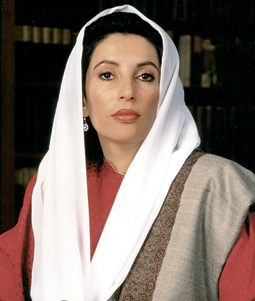 The news is ablaze; the blogs are on fire; Rawalpindi and Sind are burning. Former Pakistani Prime Minister, Benazir Bhutto, was assassinated today at a political rally in Rawalpindi, Pakistan.
The news is ablaze; the blogs are on fire; Rawalpindi and Sind are burning. Former Pakistani Prime Minister, Benazir Bhutto, was assassinated today at a political rally in Rawalpindi, Pakistan.
While few Sikhs will shed any tears for Bhutto as she was personally responsible for the deaths of many Sikhs during the 1980s, the current crisis of the neighboring state cannot be ignored.
The ramifications for the global ‘war on terror’ are yet unknown. In Pakistani circles, most believed that a Washington-brokered power-sharing agreement had been reached between General Musharraf and Bhutto. Despite the General’s declaration of ‘martial law,’ Bhutto’s criticisms had been muted. However her outcry became shriller as opposition within her political party called for her stronger support towards its beleaguered party members, who were coming under arrest and greater security scrutiny. In recent times the relationship (at least in the media) has soured.
The ramifications for Pakistani democracy may be severe. Many are speculating that Musharraf will use this event to postpone (perhaps indefinitely) the upcoming elections and further trample on any that oppose him.
 It is said, lamentation was rife amongst the people that the Sun will set, Darkness will spread, no one will be able to see anything, and what will happen to us? Everybody was worried, but the Sun set.
It is said, lamentation was rife amongst the people that the Sun will set, Darkness will spread, no one will be able to see anything, and what will happen to us? Everybody was worried, but the Sun set.